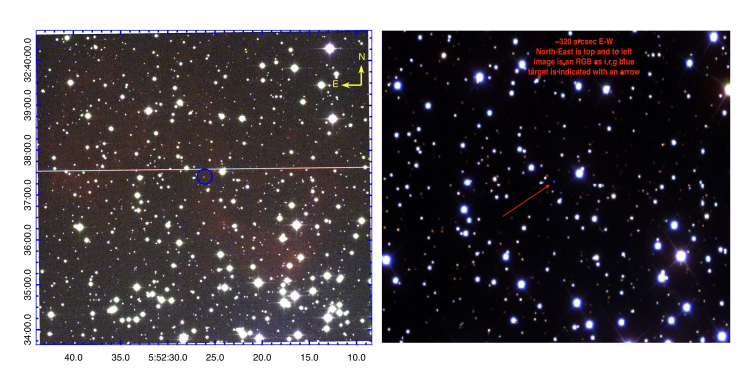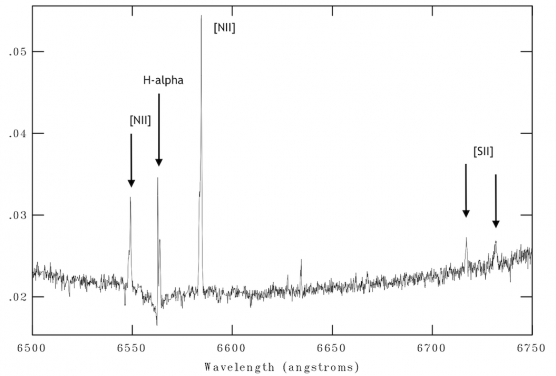Media
Discovery of the oldest visible planetary Nebula hosted by a 500 million year old Galactic cluster – a rare beauty with a hot blue heart
26 Aug 2022

Figure 5. A plot from the known sample of cluster white dwarfs for the latest IFMR estimates and semi-empirical ‘PARSEC’ fit (Cummings et al. 2018) together with our estimated point for PN IPHAS J055226.2+323724 plotted as a red circle. The other two points from known open-cluster PNe are plotted as a yellow circle (PHR 1315-6555 (Fragkou et al. 2019a) and (Parker et al. 2011)) and green circle (BMP J1613-5406 - Fragkou et al. (2019c)). The errors attached to our point reflect the errors in the adopted cluster parameters and the spread of the estimated central-star magnitudes.

Figure 1. A contrast enhanced 30°ø30 arcminute quotient (Hα−r band) IPHAS (Drew et al. 2005) mosaic centred on the core of Galactic open cluster M 37 (NGC 2099). The low surface brightness bipolar PN (IPHASX J055226.2+323724) is encompassed by a red circle with a diameter of 445 x 10 arcseconds (the nebular major axis) while the blue circle indicates the full ∼ 30 arcminute extent of the cluster. The PN is well within the cluster tidal radius with the blue CSPN at almost the precise geometric centre of the PN. The CSPN is itself only ∼280 arcseconds from the published cluster center position.

Figure 2. Fig. 2a left panel: An enhanced 6.5 x.5 arcminute colour-composite RGB image of PN IPHASX J055226.2+323724 from the IPHAS survey (Drew et al. 2005) that we confirm as a physical member of the Galactic open cluster M37. Red = Hα, Green = broad band red and Blue = broad band ‘i’. The CSPN is circled in blue; Fig. 2b right panel: 190 x145 arcsecond RGB image created from SDSS with red = i, green = r and blue = g-band. These data clearly shows the faint CSPN (arrowed) at the centre. North is top and East is to the left in both images.

Figure 3. A combined 1-d continuum subtracted example PN spectrum from March 4th 2022 for IFU pointings a, b, c and d from the paper. The 5 visible PN emission lines are labeled.
Figure 4. Cluster Gaia DR3 CMD (B versus B-R) diagram fitted with a Padova theoretical isochrone (Bressan et al. (2012), Marigo et al. (2013) for adopted cluster parameters (age = 470 +/- 50 Myrs, reddening E(B−V ) = 0.26 +/-0.04, distance = 1.49 +/- 0.13 kpc and metallicity [Fe/H] = 0.03 +/- 0.28). The CSPN is indicated by the red filled symbol. Stars with >80% probability (Cantat-Gaudin et al. 2018) of being a cluster member, where cross-correlated with Gaia DR3 and are plotted as green dots. The CMD includes all stars with pmRA =0 to 4 and pmDec = −8 to −2 mas/yr (most probable cluster members
based on mean proper motions) within 15 arcminutes from the cluster’s apparent center.

Figure 5. A plot from the known sample of cluster white dwarfs for the latest IFMR estimates and semi-empirical ‘PARSEC’ fit (Cummings et al. 2018) together with our estimated point for PN IPHAS J055226.2+323724 plotted as a red circle. The other two points from known open-cluster PNe are plotted as a yellow circle (PHR 1315-6555 (Fragkou et al. 2019a) and (Parker et al. 2011)) and green circle (BMP J1613-5406 - Fragkou et al. (2019c)). The errors attached to our point reflect the errors in the adopted cluster parameters and the spread of the estimated central-star magnitudes.

Figure 1. A contrast enhanced 30°ø30 arcminute quotient (Hα−r band) IPHAS (Drew et al. 2005) mosaic centred on the core of Galactic open cluster M 37 (NGC 2099). The low surface brightness bipolar PN (IPHASX J055226.2+323724) is encompassed by a red circle with a diameter of 445 x 10 arcseconds (the nebular major axis) while the blue circle indicates the full ∼ 30 arcminute extent of the cluster. The PN is well within the cluster tidal radius with the blue CSPN at almost the precise geometric centre of the PN. The CSPN is itself only ∼280 arcseconds from the published cluster center position.
- 1 / 5
- 2 / 5
- 3 / 5
- 4 / 5
- 5 / 5
An international team of astronomers led by members of the Laboratory for Space Research (LSR) and Department of Physics at The University of Hong Kong (HKU), have discovered a rare celestial jewel–a so-called Planetary Nebula (PN) inside a 500 million-year-old Galactic Open Cluster (OC) called M37 (also known as NGC2099). This is a very rare finding of high astrophysical value. Their findings have just been published in the prestigious open-access paper Astrophysical Journal Letters.
PNe are the ejected, glowing shrouds of dying stars that shine with a rich emission line spectrum and display, as a result, their distinct colours and shapes that make them photogenic magnets for public interest. It was no coincidence that one of the first James Webb Space Telescope (the largest optical telescope in space) images released to the public was a PN!
The PN, with the rather ungainly name of “IPHASX J055226.2+323724”, is only the 3rd example of an association between a PN and an OC out of the ~4,000 PNe known in our Galaxy. It also appears to be the oldest PN ever found. The small team led by Professor Quentin PARKER, Director of the HKU LSR, have determined some interesting properties for their discovery: the authors found the PN has a “kinematic age” of 70,000 years. This estimate is based on how fast the nebula is expanding, as determined from the PN emission lines, and assuming this speed has remained effectively the same since the beginning, and is the time elapsed since the nebular shell was first ejected by the host, a dying star. This compares to typical PN ages of 5,000-25,000 years. It is truly a grand old dame in PN terms but of course a mere “blink of the eye” in terms of the life of the original star itself that runs to hundreds of millions of years.
Because this “grand old dame” lives in a stellar cluster, this environment enables the team to determine powerful additional parameters not possible for the general Galactic PN population. These include estimating the mass of the PN’s progenitor star when it turned off the stellar main sequence, as derived from the observed properties of the thousands of stars in the cluster when plotted in a so-called colour-magnitude diagram. The team can also estimate the residual mass of the central star that ejected the PNe via theoretical isochrones and observed properties of the hot, blue central star. As a result, they figured how massive the star was that ejected the PN gaseous shell when it was born and how much mass is now left in its residual, contracting hot core (which is already a so-called ‘White Dwarf’ star). Fresh “Gaia” data for the hot blue, PN central star also provide a good distance estimate allowing the PN’s actual size at this extreme age to be determined as 3.2pc (parsec, an astronomical unit of measure for interstellar space with 1pc equals to 3.26 light-years) in diameter – unsurprisingly perhaps also at the extreme end of known PN physical sizes.
Former HKU PhD student Dr Vasiliki FRAGKOU, the first author of the study stated, “I am so excited to be able to work on these fascinating rare cases of OC-PN associations because they keep turning up important science results, like all three cases we have found are butterfly (bi-polar) PN in terms of shape, all are very faint and highly evolved, and all have Type-I chemistry according to their emission lines, and of course all have intermediate to high progenitor masses.”
Corresponding author Professor Quentin Parker said, “This is only the third example of a PN found in a Galactic open star cluster, and my group has found all three confirmed examples. They are incredibly rare but also very important as these beautiful objects allow us to independently determine points on the so called initial to final mass relation (IFMR) for stars – an important astrophysical relation – independent of the traditional method of using white dwarfs in clusters. Intriguingly, all our points lie just below the empirical IFMR trend currently established but add to the “kink” in this relation found recently in the 2-3 Solar mass range for the original progenitor mass by Marigo et al in the Nature Astronomy journal. Our OC-PN points fortuitously are found in currently sparsely populated regions of the IFMR, making them even more valuable.”
Co-author Professor Albert ZILJSTRA, Hung Hing Ying Distinguished Visiting Professor in Science and Technology at HKU LSR from the University of Manchester commented on the PN visibility lifetimes which have previously been much shorter in the general Galaxy. “This new result implies that the location of a PN in an OC provides an environment suitable for allowing the PNe to expand and fade without disruption by the ambient ISM (which is typically much weaker in an OC) and not as would be the case in the Galaxy.”
The journal paper can be access from here: https://doi.org/10.3847/2041-8213/ac88c1.
About LSR:
The LSR is well situated in a dynamic region of Asia to foster links with the astrophysics, space and planetary sciences community in China and globally. The LSR’s interdisciplinary research launches various bids to exploit and access the emerging Mainland funding and research environment. We have developed multilateral and strategic partnerships with world-leading universities, space science institutes and participate in large, international, high-impact space missions. Website: www.lsr.hku.hk
Image download and caption: https://www.scifac.hku.hk/press
For media enquiries, please contact Ms Casey To, External Relations Officer (tel: 3917 4948; email: caseyto@hku.hk / Ms Cindy Chan, Assistant Director of Communications of HKU, Faculty of Science (tel: 3917 5286; email: cindycst@hku.hk).
